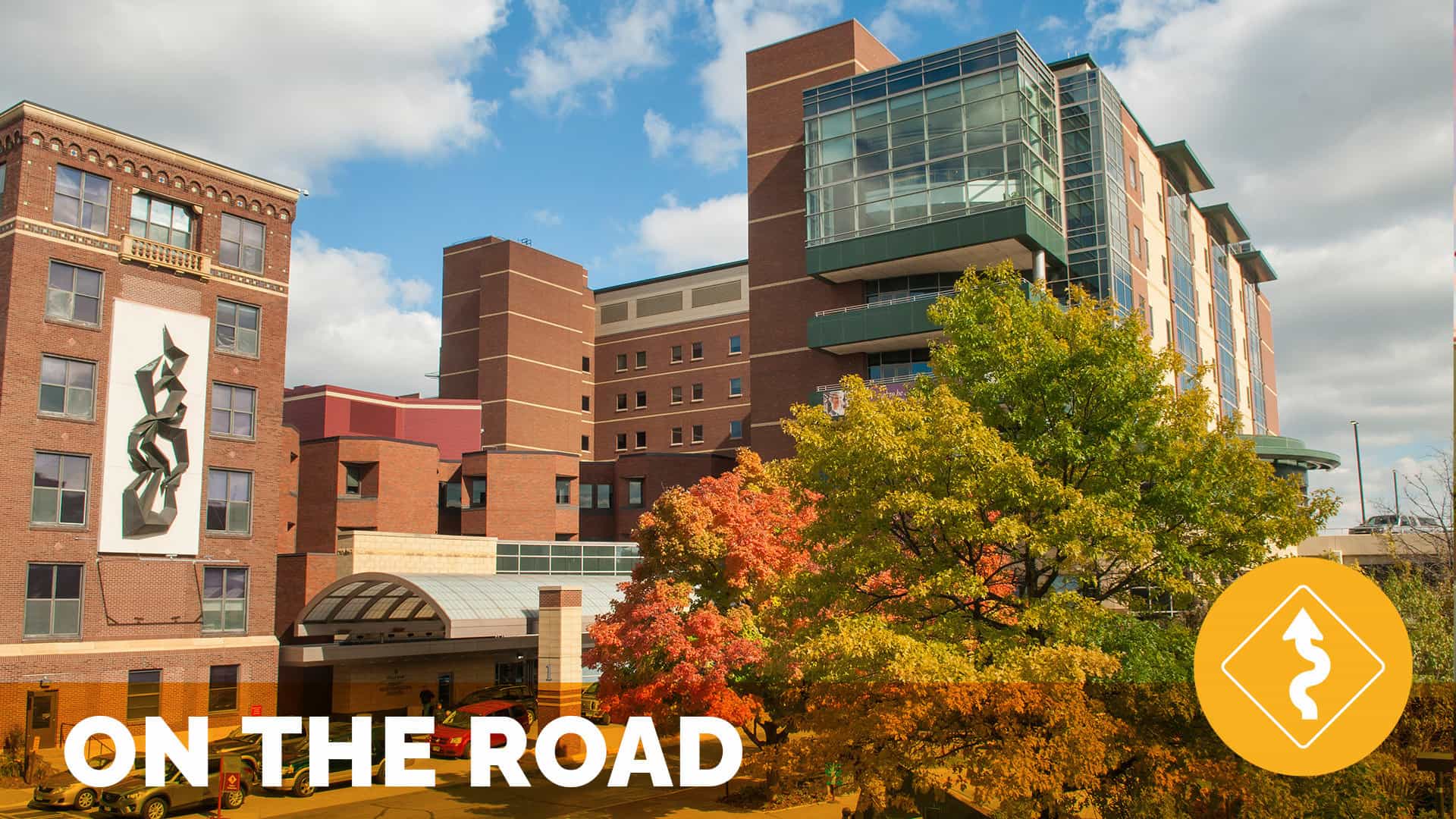Driven by the Patient Voice

On the Road with Allina Health – July 2015
by Deanna Frings
Our latest On the Road took me to Allina Health where they are helping people live healthier lives in communities throughout Minnesota and western Wisconsin. Allina Health is a large integrated health care system providing a full range of services with over 26,000 employees, 5,000 associated and employed physicians and more than 4,100 volunteers.
My hosts for the day were Tracy Laibson, Director of Patient Experience, Hospital Division, Janet Wied, Director Patient Experience, Allina Health Group and Dr. Steve Bergeson, Medical Director, Allina Health Group. Throughout my day they reviewed the history and evolution of their patient experience journey, the positive impact of a new CEO and their optimism for Allina Health’s patient experience future.
Looking Back
Allina Health’s 10 plus year patient experience journey began much like many health care organizations around the country with a focus on patient satisfaction surveys and data management. In 2000 due to financial pressures, the decision was made to manage the patient satisfaction survey process internally. While the internal process was highly successful, it became increasing more important to have national benchmarking.
In 2009 Allina Health moved back to an external survey vendor to allow internal staff to focus on performance improvement. This allowed the organization to shift the conversation away from the survey process and began asking questions like, “What are our patients reporting compared with patients of other organizations; what is this data really telling us and what can we do with it to improve the patient experience?” This, along with the initial shock value experienced when the first rankings came out, was a clear recognition and key driver for a continued strategic focus on improving the patient experience.
It became apparent to me early in my visit that Allina has and continues to demonstrate key qualities of a learning organization. That is, a culture that encourages and supports continuous learning, values critical thinking and applies what it has learned from improving quality to improving the patient experience. The Primary Care service line has seen “willingness to recommend” increase from the 35th to the 79th percentile over 3 years.
New Beginnings
In January 2015, Dr. Penny Wheeler became the CEO and with that came a renewed dedication on patient voice and patient experience. Dr. Wheeler brings a unique perspective to Allina. She was actually born at Abbott Northwestern Hospital, the largest not-for-profit hospital in the twin cities and part of Allina Health System. She was a practicing physician at the same hospital, part of the Medical Executive Committee, Chief Medical Officer and now CEO. Her message is clear, that patient stories drive everything we do.
Another theme emerged throughout my visit – the focus on doing things with clear purpose, intention and consistency. A great example shared was the CEOs Friday email message. This is a long honored tradition that Dr. Wheeler has continued and her message often incorporates the patient voice or patient stories. It was shared with me that doing this one small activity consistently over time has begun to change the culture and is an impactful way for Dr. Wheeler to personally connect with every person throughout Allina Health.
I had the privilege to spend some time with Dan McGinty, Executive Vice President of Hospital and Specialty Services. He provided a great overview of the three focus areas for 2015. This was yet another example of how doing a few important things with clear purpose, intention and consistency is far more impactful than struggling to do many things occasionally and another lesson learned.
Focus on What Matters Most to Our Patients
A critical part of the patient experience culture at Allina Health is focusing on what’s most important to the patient. Three key initiatives have risen to the top of that priority list at Allina Health’s hospitals for 2015.
Leader Rounding both with staff and patients is a clear expectation for all leaders including the Executive Team. Dan rounds every month at one of Allina’s 13 hospitals. He knows it is important to role model the behavior and its value in sending a clear message that this is a priority. He also confessed, “I love that day. It’s a great opportunity to thank our patients and families for trusting us with their care.”
Bedside shift handover is the second focused priority. This is not a new expectation but one that Allina continues to focus on to reach the level of consistency and quality they know is critical in creating an exceptional patient experience. While the data does not drive their strategy, it definitely communicates back to them how well they are doing in this area. It is without a doubt that the areas doing bedside shift handovers with intention and consistency have received very positive feedback from patients and families particularly in the area of RN Communication.
4 C’s
Last but certainly not least is using the 4 Cs, a targeted initiative Allina Health’s hospitalists and other inpatient providers. Again, based on what they have learned is important to their patients, the 4 Cs are defined behaviors and tools used by the physicians to more fully convey care, concern and key information. The 4 Cs include:
Cards with a photo, introducing and explaining the role of a hospitalist
- Care boards communicating key information
- Chairs in the room to encourage physicians sit and make eye contact when visiting with patients
- Connect to emphasize making a personal connection with patients, connect with the care team and keeping the patient up to date.
Dan was fully transparent in sharing while he would like to say the three areas are universal, he recognizes there is more work needed to increase the level of consistency. However, he does believe they are close to a critical mass in achieving these goals.
Involving Patients and Families
Part of my visit included meeting Sara Arnold, Patient Experience Advisor responsible for the Patient and Family Partnership Program. Allina Health has a robust program dedicated to seeking patient and family input to drive improvement. After completing an application and going through an interview process, those selected have opportunities to tell Allina Health what matters most to them, help improve care and how it is delivered, identify areas to consider for improvement and be an advocate for health care innovation and improvement. There are several ways to participate:
- Advisory council: This is an in-person, quarterly meeting of patients and family members who have experienced a variety of care settings across Allina Health.
- Focus groups: These are in-person or virtual meetings held as needed. Focus groups will provide feedback on topics related to selected medical conditions or care settings.
- Virtual feedback: When there is a need for timely, topic-specific feedback, patients and family members can participate via email conversations, phone interviews or online surveys.
- Committee participation and panels: When patient and family participation is needed on an ongoing basis, these advisors will be invited to join committees. When the voices of patients and families are needed for meetings, conferences or programs, these advisors will be invited to present their stories either individually or as part of a panel.
The value Allina places on including the patient voice is evident in multiple ways. Dr. Tim Sielaff, Allina Health Chief Medical Officer, Senior Vice President Specialty Care & Research was very clear “patients and families can drive our agenda better or as well as our scores can. Bring patients in and they will change the conversation…we should have them present.”
Patient Experience Design
In the afternoon I traveled to Champlin Clinic, a long standing Allina Health Clinic that moved into a new facility just prior to my arrival designed around the experience of both patients and staff. The leadership of the Clinic Division is in the process of redesigning primary care focused on the needs of the patient relationship. They call it Personal Primary Care Team (PPCT). The objective is to have dedicated care teams working together when caring for patients. Each care team consists of 3.5 full time equivalents (FTEs) with the break down as follows:
1 FTE = physician
2 FTEs = Medical Assistants
0.5 FTE = Registered Nurse
Champlin Clinic was in need of a new building so the opportunity was perfect to design the space with the new model in mind. The initial results have been extremely favorable from both the perspective of the staff and the patients.
Some of the important design elements include lower counters at the check in desk, partial partitions for privacy while still creating an open welcoming environment, coffee station with a sink (the emphasis is on the sink), pediatric waiting area, work area in the waiting room equipped with a computer and other work essentials, private weighing station and no need for patients to step up onto a scale because the scale is built into the floor and exam rooms located immediately behind the lobby eliminating the need for long walks through a maze to reach your destination. The elimination of unnecessary walking has benefited the staff as well.
Laboratory and Radiology Team
I was impressed with the level of detail that was taken into consideration and evident in the final product. The use of natural light and intuitive way finding was innovative. Both the staff and patients were integral in its design and the positive results were evident during my tour and echoed by the clinic leadership, Linette Jacobson, clinic manager, Jill Bergen, clinical services supervisor and Jackie Kerfeld, business services supervisor.
I also met some great people from the laboratory and radiology areas. They confirmed how much they appreciate their new work environment and participating in the design process. Bonnie Verke, medical lab technician, Champlin Clinic, expressed her thoughts very simply, “It’s a happy day every day.” And this is all because their request for a window was realized. A wonderful reminder that it usually is about the little things that are most important.
Having a brand new building is exciting but Janet did reinforce, “its not that we can build a brand new building everyday but there is a lot we can do.” The PCCT model is being implemented in many clinics across Allina with favorable results. The staff has welcomed the team approach and the work continues to evolve as improvement ideas continue to flow.
Future Looks Bright
I left my visit feeling very excited for Allina Health. Every person I interacted with talked positively about the current focus and work being done to impact the patient experience. Like many health care organizations, patient experience is not a new journey at Allina Health and as they continue to keep focused on their true north guided by the patient stories, the critical mass Dan talked about earlier will no doubt be realized. Dan and the others are optimistic about the future of the health care industry and about Allina Health. I look forward to returning this fall for one of our three Regional Roundtable events and to hear about their ongoing progress.
Related content
-
 Patient Family & Community Engagement
Patient Family & Community EngagementThe Use of Patient Stories as a Knowledge Translation Strategy to Facilitate the Sustainability of Evidence-Based Interventions (EBIs) in Healthcare
Patient stories are real-life experiences told from a patient’s or their family’s perspective. In the past, patient stories have served many purposes in healthcare, such as spreading knowledge, educating providers, or conveying the patient experience. Patient stories are increasingly used as a knowledge translation (KT) strategy to improve the uptake of evidence-based interventions (EBIs) into
Learn more -
 Patient Family & Community Engagement
Patient Family & Community EngagementFormer Patients Who Return As Volunteers: An Expression of Gratitude
Alex Seblatnigg, Director of Volunteer Services and Internal Engagement at Shepherd Center—a leading rehabilitation facility specializing in spinal cord and acquired brain injuries—shares the inspiring stories of former patients who return as volunteers after discharge. Tune in as she highlights the unique value these volunteers bring to the patient experience and how they seamlessly integrate
Learn more -
 Patient Family & Community Engagement
Patient Family & Community EngagementPatient, Family, and Health Professional Perspectives of How Families are Involved in Adult Inpatient Traumatic Brain Injury Rehabilitation
Objective: We aimed to answer the following research question: From the perspectives of patients, family members, and health professionals, how are families involved in the rehabilitation of adult patients with Traumatic Brain Injury at an inpatient Acquired Brain Injury service within an adult rehabilitation centre? Methods: We used an interpretive qualitative approach, from a constructivist view.
Learn more
